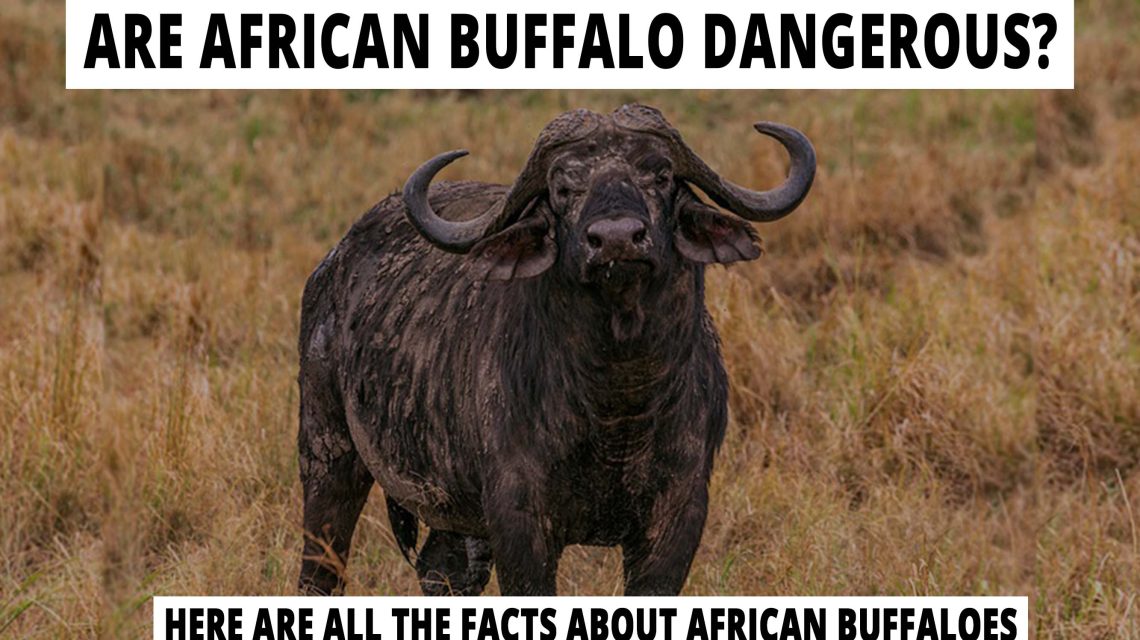The African Buffalos are native to the Sub-Saharan regions of Africa. The mopane grasslands, floodplains, swamps, forests and mountains in Africa. The buffalos live as a herd, and the pack members have a good bond. The countries Chad, Congo, DR Congo, Central African Republic, Burkina Daso, Burundi, Benin, Botswana and Angola are the more popular countries of African Buffalo habitats. An African Buffalo’s life span is between 11 to 29 years; the approximate weight would be 250 to 1000 kilograms, and the height would be 1.7-3.4 meters. The African Buffalo belongs to the Mammalia class and the Bovidae family. The African buffalo is also known as the Cape buffalo. The Cape Buffalo or the African Buffalo have two subspecies: Sudanese Buffalo(Syncerus caffer nanus) and Forest Buffalo(Syncerus caffer brachyceros).
Diet
The African Buffalos are herbivorous; they depend on different varieties of grasses, leaves, sedges and other plants.
Population
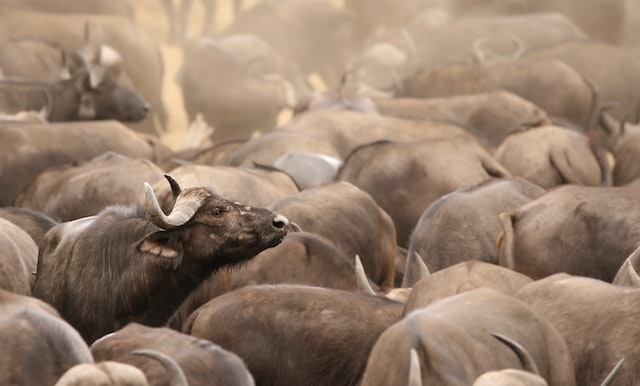
According to the reports of IUCN, the African Buffalo population is on the red list. The total population of the African Buffalo is between 569,00-573,00 numbers. The African Buffalo species is classified in the Near Threatened list.
Habits and Life Style
The African Buffalos are active animal species engaged in both day and night types. The African buffalos live in herds and are considered social animals. A pack consists of female buffalos and also dominant males. The dominant adult bulls have more prominence in a herd, the young males keep their distance from those dominant bulls, and the dominancy and the adulthood of a bull decide by the thickness of their horns. The males leave the herd during the dry season, and during the wet season, the males return to the pack to mate with the females. Until the birth of the calves, they protect the females and calves. The protection of the members’ lives in the herd increases when the member number is more significant. The togetherness of the pack strengthens them to protect themselves from predators. The African Buffalos have different vocalisations variations; they mark the signals to move the herd, change the direction and communicate with the others in the pack. The herd name is gang as well. The males leave during the dry season but are not considered migrant creatures.
The African buffalos mainly get hunted by lions as they are one of the favourite prey of lion species. The lions need more strength and more members to pursue a buffalo. With the help of their sharp horn and strong hooves, the buffalos defend themselves from the lions. When one member of a herd gets into such a dangerous situation, the pack acts together to protect themselves, but they do not attack; instead, they make noise and run so that the lion can not attack the whole herd at once, but the old and young once get hunted.
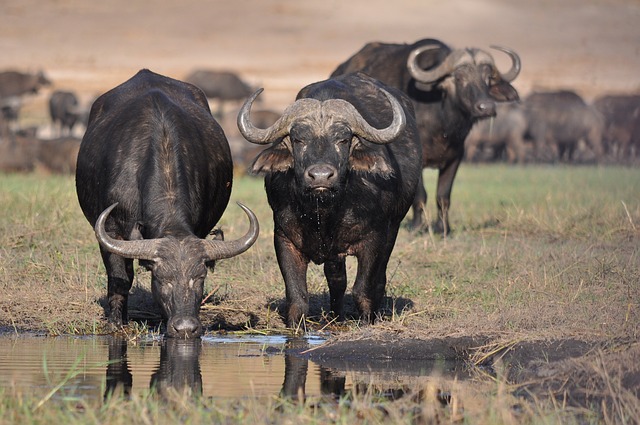
Are African Buffalos found in Victoria Falls?
Victoria Falls has now become a place to find the African Buffalo species. Victoria falls become a popular place for people to witness wild animal life. Still, if you plan to visit there and see the African buffalos, you need a professional guide because they tend to get aggressive if they feel dangerous.
Difference between male and Female Buffalos
Scientifically the male and female, male buffalos differ from the sexus=al dimorphism. Between Buffalos, the male buffalo is more extensive than the female buffalo. Also, we can find slight differences in the shape and the sizes of the horn, but taking all in common, there are many similarities between male and female buffalos. The female’s horns are thicker and more powerful, grow together with their age, and cover the top of their head. This is a natural formation to keep their skull under protection. But in female buffalos, the horns grow from the sides of their head and cover their hair. The female horn is much thinner and lighter, but they grow more extended than the male horns.
Mating
The mating and the breeding of the births are given during the rainy season. The dominant Bull keeps the other Bull away from the female one and protects the female buffalo until the mating. The reproduction is done every two years. The gestation period lasts 11.5 months, and gives birth to a single calf at a time. The calves are kept outside of the herd for a week, and in the vegetation, the calves are nursed by the female cow. When the calves get two years old, especially the male calves leave their mother and join bachelor groups. When a calf reaches one or two age, they become independent and get detached from its parents. The young females start to breed t 5 years of age.
Threats
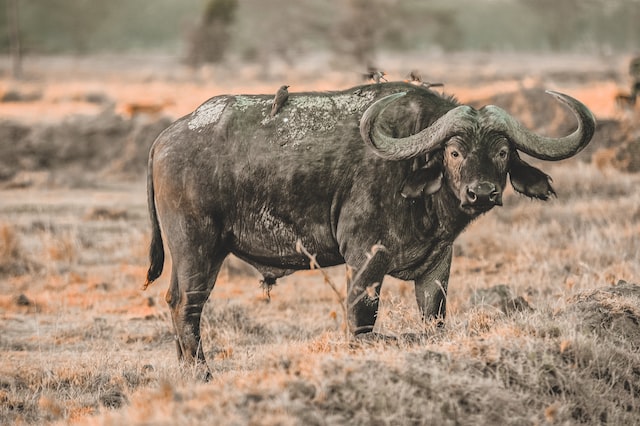
The expansion of settlements and agriculture, livestock grazing and fragmentation have caused threats to the livelihood of the African Buffalos. Since African Baffalos belong to the five most dangerous animals in the world, they were also taken into the five-game family. Also, buffalos are hunted for meat.
Are African Buffalos Dangerous?
generally, the African Buffalos are considered an aggressive species. The herd of buffalo is fairly passive, but during the season of mating and in taking the dominancy of the herd they behave much like cows. The older alone bulls are much more dangerous, the reason for them to be aggressive like that is they are detached from the herd and they lack protection. Their body language is quite difficult to understand as they make fewer signs of aggression. When an African Buffalo gets aggressive it can make a human fly by hitting him using its sharp horn and the flick of its muscular neck.
Facts about African Buffalo
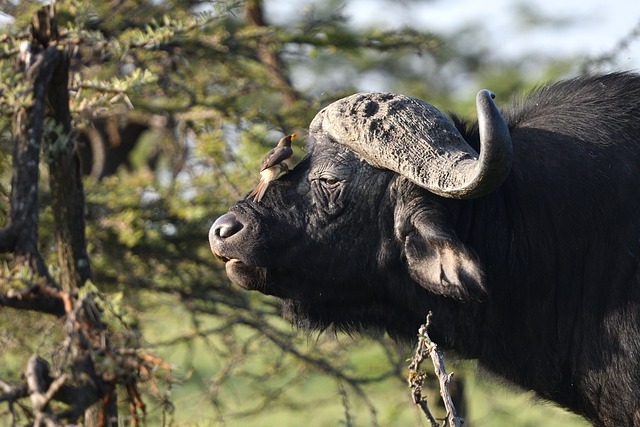
- The African buffalos are very dependent on water.
- The African buffalos drink 35 litres of water within a few minutes.
- The African Buffalos are excellent swimmers.
- The African Buffalos live in herds and fight with predators for protection.
- The African buffalos are included in the big five aminals, which take five games.
- The African Buffalos, also name “Black death” or” Widowmaker.”


